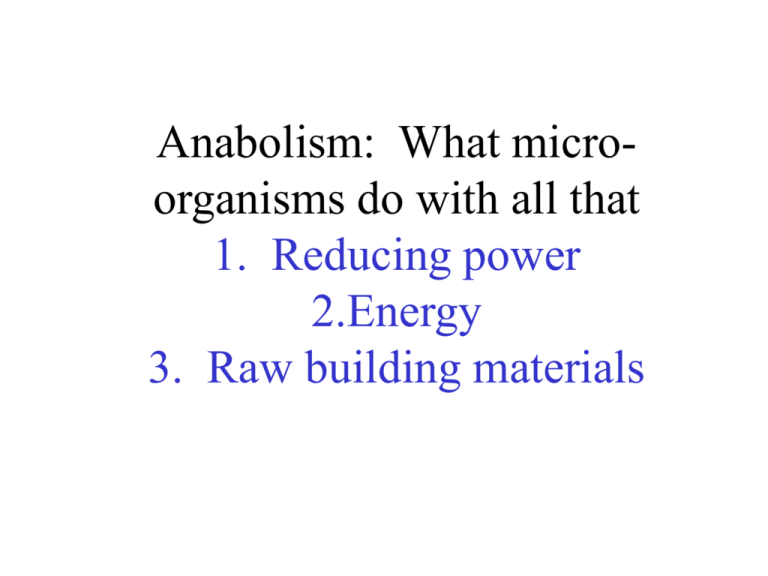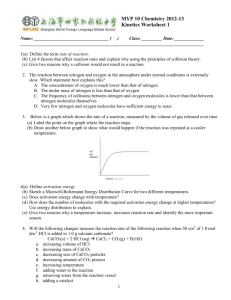Anabolism: What micro-organisms do with all that 1. Reducing
advertisement

Anabolism: What microorganisms do with all that 1. Reducing power 2.Energy 3. Raw building materials Reducing Power NADH/FADHglycolysis and Kreb’s cycle NADPH oxidative photophosphorylation NADPH anaerobic photophosphorylation 1. Reverse electron flow 2. Protons from inorganic molecules (H2S, S2O3) Protons leached from Fe-S containing molecules in PSI in anaerobic photo-phosphorylation Energy--ATP 1. Oxidation of organic molecules (glycolysis/Kreb’s cycle) 2. Electron transport: A. oxidative phosphorylation (PMF) chemiosmosis)— oxygen the final proton/electron acceptor B. anaerobic– inorganic molecules final electron acceptor 3. Oxidation of inorganic molecules (usually fed into electron transport chain) 4. Dissimulative reduction of inorganic molecules (CO2, sulfides and iron 5. Oxidative and anaerobic photophosphorylation Raw building materials Carbon/Nitrogen/Phosphorous etc. from the catabolism of carbohydrates lipids proteins nucleic acids strange organic matter such as petroleum Carbon from CO2 fixation Nitrogen from Nitrogen (N2) fixation Etc. Integrated pathway for catabolism and anabolism CARBOHYDRATES Ribose Glucose Phosphoglycerate A.A A.A. LIPIDS Phosphoenolpyruvate Fatty acids Kreb’s cycle A.A. Pyruvate oxaloacetate Acetyl-CoA NUCLEIC ACIDS purines pyrimidines Amino acids succinate Amino acids n.b. amino acids (A.A) Amino acids PROTEINS a-keto glutarate One strange thing bacteria can eat for energy and biomass—Petrol !!! Mediated by oxygen and the enzyme mono-oxygenase variety of yeasts/ molds and bacteria Another strange thing—benzene/toluene Requires oxygen, NADH. Aliphatic carbons are converted to linear molecules that can be catabolized to succinate/Acetyl-CoA/pyruvate which enter Kreb’s cycle—Pseudomonas spp. CO2 fixation (Calvin cycle, reverse TCA cycle and hydroxy-proprionate cycle) How autotrophs reduce CO2 into material they can use for biomass. Calvin cycle In: CO2, NADPH and ATP Out: Fructose-6 phos intermediate of glycolysis Reverse TCA cycle Hydroxy-proprionate cycle Nitrogen fixation: atmospheric nitrogen to fixed nitrogen that can be utilized by plants and bacteria Agricultural significance of nitrogen fixation: Crop rotations with plants that form intimate symbiotic relationships with Rhizobium spp. (bacteria in root nodules) peas, beans, soybean, alfalfa, clover Pre seed watery environments with cyanobacteria (Anabaena azollae) and the water fern Azolla. Plant rice as rice plants grow they crowd out and kill the water fern thus releasing the nitrogen that they require pgs 685-692 in text book







